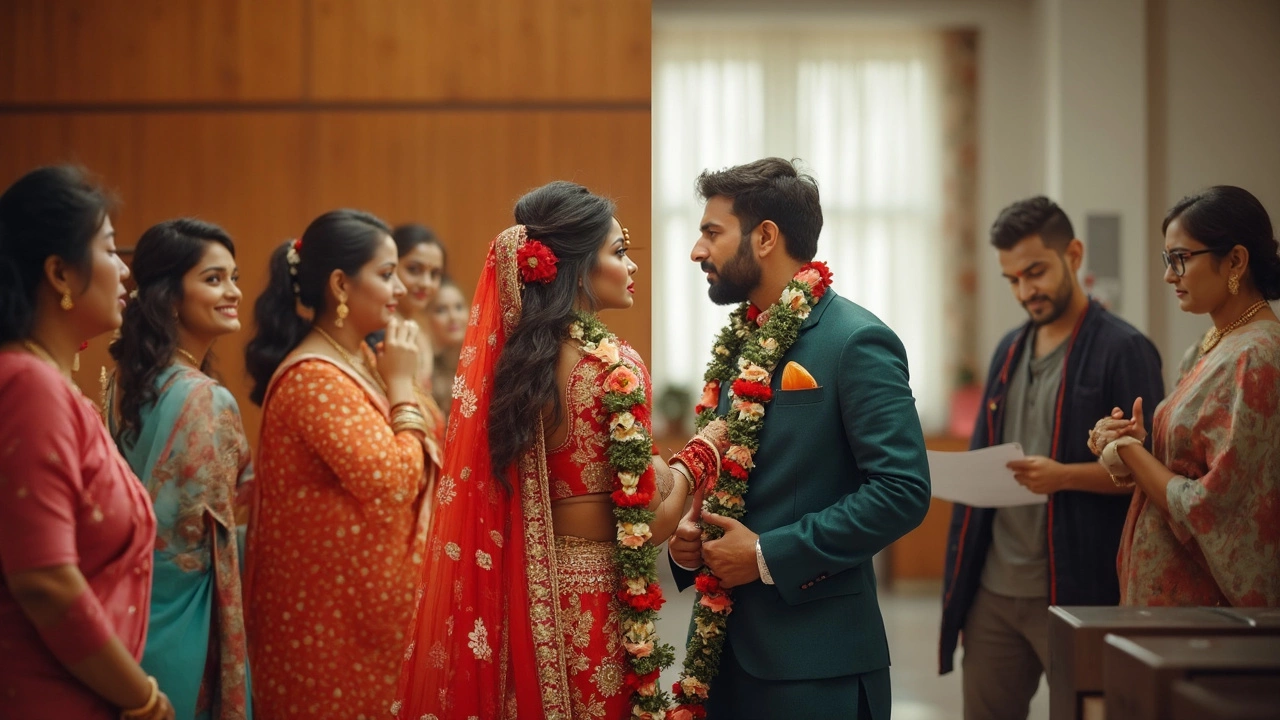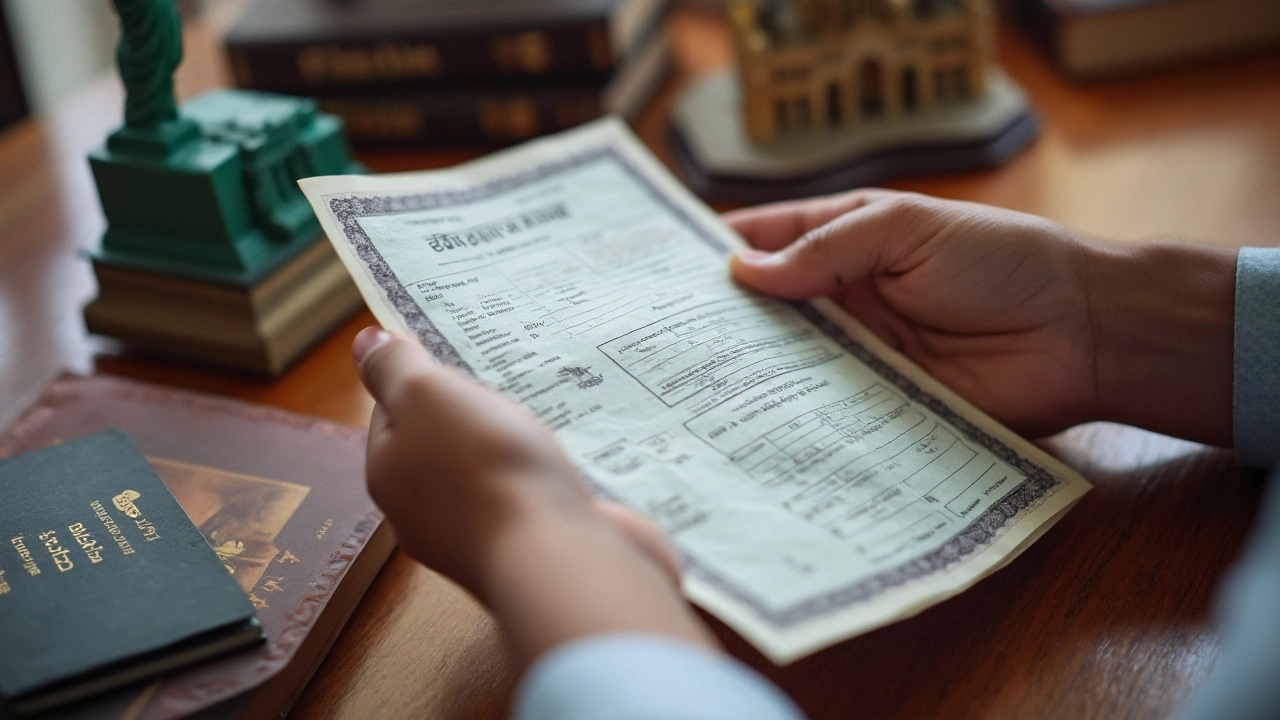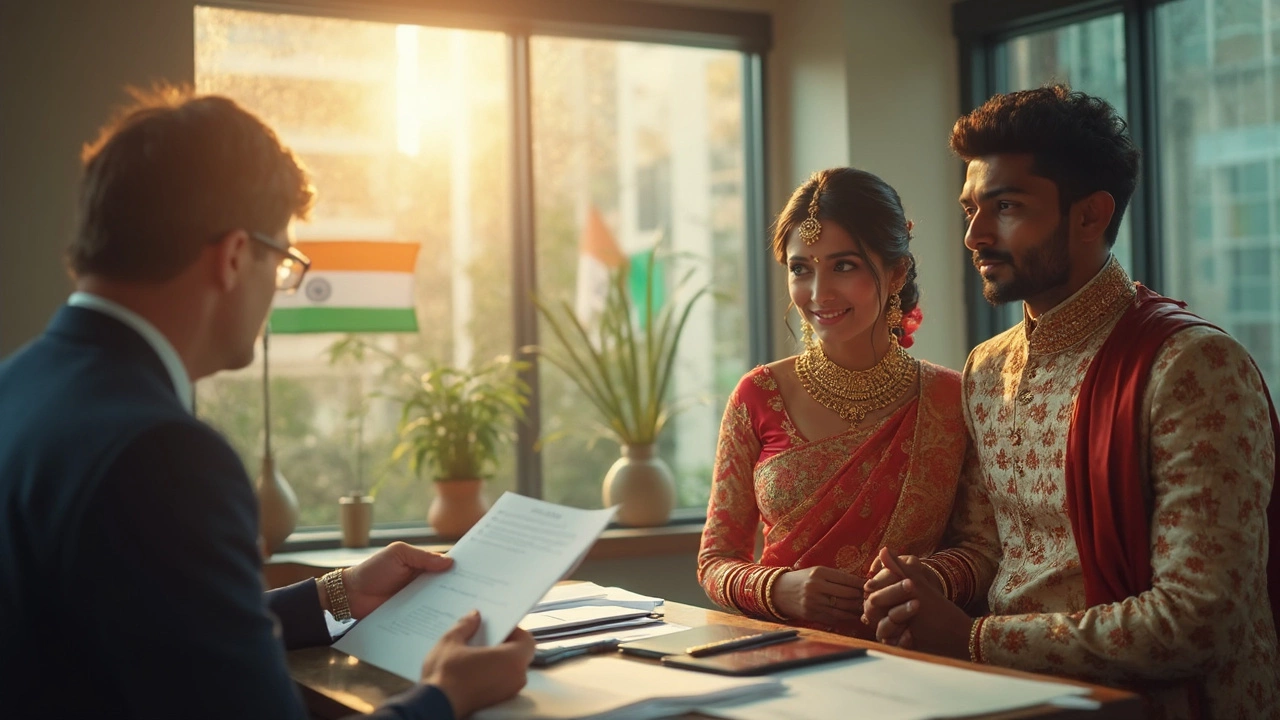Figuring out if you can register your marriage in the US isn’t as tricky as it sounds—but you do have to know the rules. If you got married in India and want the marriage recognized here, you don’t actually have to “register” it again in the US. Most states accept a valid foreign marriage (including Indian ones) as long as it followed both countries’ laws. Sounds easy, right? There’s a catch: you’ll need proof, usually an official marriage certificate from India, preferably translated into English and, sometimes, apostilled for authentication.
This whole process matters if you need to update your legal status, apply for a spousal visa, or add your spouse to insurance. US offices aren’t picky about wedding rituals—they care way more about valid documents with seals and signatures. Make sure names, dates, and details on your certificate match your passports and other ID. Even small typos can mess things up, so double-check everything before you hand it over.
- Who Needs to Register an Indian Marriage in the US?
- Rules for Recognizing Indian Marriages in America
- Documents You’ll Need (and Where to Get Them)
- Steps for Marriage Registration: A Simple Walkthrough
- Smart Tips for Avoiding Common Mistakes
Who Needs to Register an Indian Marriage in the US?
If you’re an Indian couple living in the US, you might wonder if your wedding back home counts here—or if you need to do some sort of marriage registration process again. The truth is, you don’t always need to "register" your Indian marriage in the US. The key question is: do you need your marriage legally recognized in the US for some reason—like applying for a green card, dealing with taxes, health insurance, or inheritance? If yes, then you need to show proof your Indian marriage actually happened and is legit.
The rules are pretty clear: as long as your marriage in India followed Indian law and both of you could legally marry, most US states will recognize it. That means you don’t need a new ceremony or a new US marriage license. But if you didn’t register your marriage properly in India (read: no marriage certificate), you can hit major roadblocks. No wedding photos or invitations will work—official documentation is a must in the US system.
Some common groups who’ll need to prove or register their Indian marriage in the US include:
- Indian citizens with a US green card or citizenship bringing a spouse to the States (hello, immigration paperwork!)
- NRIs (Non-Resident Indians) who got married in India but live in the US and need joint tax filing, family visas, or spousal benefits
- Anyone needing to update US records, like your Social Security details or driver’s license, to show your marital status changed
Here’s a quick table that shows why people living in the US might need to show their Indian marriage registration:
| Situation | Why You Need Proof |
|---|---|
| Immigration (Visa/Green Card) | USCIS wants a valid marriage certificate |
| Adding Spouse to Health Insurance | HR department requires proof of relationship |
| Changing Last Name | DMV and SSA need an official marriage record |
| Tax Filing | IRS needs documentation for ‘married filing jointly’ |
In short: if dealing with any official US process where marital status matters, your best friend is a properly registered Indian marriage certificate. Make sure it’s a government-issued document, not something you got from a temple or wedding planner. Paperwork makes all the difference here!
Rules for Recognizing Indian Marriages in America
Here's the truth: the US doesn’t make it hard to recognize a marriage registration from India. American law says if your marriage is valid where it happened, it usually counts here too. There isn’t a separate “US” marriage certificate waiting for you at city hall. Your official Indian marriage certificate does the heavy lifting.
But what does a "valid" marriage mean in this case? US authorities check three things:
- You followed Indian law (or local laws) when you got married.
- The marriage isn’t against US state laws—for example, both people are over the minimum legal age, not already married to other people, and the relationship isn’t within banned degrees of relationship (like close cousins, depending on state).
- You have a genuine, government-issued marriage certificate—usually in English or with a certified translation.
If your marriage is registered with an official Indian Municipal Office, Sub-Registrar, or Marriage Registrar, your certificate is what you’ll need. Bonus tip: Some embassies and US immigration offices might ask for an apostille stamp, which is basically just international verification—it’s not hard to get in India, but don’t skip it if you’re asked.
Sometimes people run into problems because their Indian certificate uses initials instead of full names, or because it’s missing critical details. Take the time to compare your marriage certificate with your passport info before you start paperwork in the US.
Now, here’s a quick comparison so you know how the US treats foreign marriages:
| Foreign Marriage Location | Recognized in US? | Extra Steps Needed? |
|---|---|---|
| India (Registered, Valid Certificate) | Yes | Maybe translation & apostille |
| India (Traditional Ceremony, No Registration) | No | Need to register in India first |
| Other Country (Valid Documentation) | Usually | Follow same rules: valid certificate, check details |
Bottom line: the US doesn’t care so much about how the wedding happened, but about the paperwork and whether your Indian marriage registration stands up to scrutiny. If you’ve got that sorted, you’re in a good place for visas, taxes, or insurance benefits here.

Documents You’ll Need (and Where to Get Them)
If you want your Indian marriage recognized in the US, paperwork is everything. The main document you’ll need is your official Indian marriage certificate, issued by a government authority back in India. It should show your names, the date, place of marriage, and signatures. US authorities do not accept those pretty invitation cards, religious certificates from priests, or even photos as legal proof. Only the formal government document does the trick.
If your marriage certificate is in any Indian language other than English, get it translated by a certified translator. Some US agencies will ask for an apostille—that’s a special stamp to prove the document’s real. You can get this after your marriage registration at the Sub-Divisional Magistrate or the Registrar’s Office in your marriage district. An apostille is issued by the Ministry of External Affairs in India. If you missed this step while you were in India, you can still get it through Indian embassy services in the US.
You’ll also need your passports, visas (if you’re not a US citizen yet), and proof of residence in the US. If you’re planning on applying for a spousal visa or green card, they’ll ask for things like birth certificates, proof of ongoing relationship (joint bank accounts, lease agreements), and ID photos.
- Indian Marriage Certificate – Official, government-issued, with all key details
- Certified English Translation (if needed)
- Apostille from Indian Ministry of External Affairs
- Valid Passports of both spouses
- Proof of Legal Entry to the US (visa, I-94 printout, etc.)
- US Address Proof if relevant
- Birth certificates (needed for some petitions)
About 75% of marriage-based visa rejections in the US happen because of incomplete or incorrect paperwork, according to the latest USCIS data. Double-check everything before you submit.
If you lost your Indian marriage certificate, you’ll have to contact the Registrar in the city where your marriage was registered. You can send a family member with a signed authorization or reach out to the Indian embassy for help from abroad. For translations and apostilles, plenty of legit translation agencies and travel service shops in India can get things moving fast—for an extra fee, of course.
Steps for Marriage Registration: A Simple Walkthrough
If you're trying to get your marriage registration sorted in the US after a wedding in India, there are a few tasks you can’t skip. The US won’t actually “register” your marriage again, but you need your paperwork in order to get things like a green card or change your legal name. Here’s exactly how to tackle it:
- Get Your Indian Marriage Certificate: Make sure you have the official government-issued marriage certificate, not just the one from your wedding priest or venue. If it’s in a regional language, you’ll need a certified English translation.
- Apostille or Notarize (If Needed): Some US offices—like immigration or DMV—might ask for your certificate to be apostilled by the Indian Ministry of External Affairs. This stamp proves your certificate is legit internationally.
- Translate Your Certificate: If your marriage certificate isn’t already in English, you must get an official, notarized translation. Don’t use Google Translate—US authorities need a certified translation.
- Bring All Your Docs: When you submit for things like a spousal visa, Social Security update, or joint tax filing, always include:
- Marriage certificate (apostilled and translated, if needed)
- Passports (both spouses)
- Any divorce/death certificates from earlier marriages (if this isn’t your first ride)
- Proof of consistent name spellings and birth dates
- File Applications in the Right Place: Submit your paperwork to the exact agency you need—USCIS for immigration, DMV for ID changes, SSA for Social Security. Each one has its own rules, so follow their checklists closely to avoid drama.
Fun fact: A 2023 USCIS report said almost 15% of Indian marriage cases get delayed because of missing or wrongly filled paperwork. Double-check those details. Names, dates, and spellings should match across all your documents. One innocent typo can set you back months.
| Step | Why It Matters |
|---|---|
| Get Certificate | Proof of marriage registration |
| Apostille/Translate | Makes certificate usable in the US |
| Document Check | Avoids delays from mismatched info |
| Right Agency | Each US agency needs the docs for different purposes |
Remember, no US office cares about your wedding style—they just want evidence your marriage registration from India is real and accurate. Stick to this checklist, and you’ll avoid the most common hassles.

Smart Tips for Avoiding Common Mistakes
Let’s be honest—messing up paperwork can turn registering your marriage into a total headache, especially if you’re trying to do it in the US with a marriage from India. The biggest mess-up people make is thinking any Indian wedding certificate will work. Nope. It needs to be government-issued (from the municipal office or registrar, not from your wedding venue or temple) and in English, or else translated by a certified translator.
Another common slip-up is skipping the apostille step. If you’re dealing with US immigration (like a green card or spousal visa), most likely you’ll need your Indian marriage certificate apostilled. That’s just a special government stamp proving it’s real. You can get it done through India’s Ministry of External Affairs—don’t let anyone overcharge you for this; it’s a pretty standard service.
People also often forget to make sure their personal info matches across all documents. If your passport says “Amit Kumar” but your Indian certificate adds your dad’s name or an extra letter (trust me, it happens a lot), you might run into red tape. When in doubt, fix the error in India before you even bring the papers here. Fixing it later in the States is slow, expensive, and usually means mailing stuff across the world.
Here’s a checklist to stay out of trouble:
- Use an officially issued Indian marriage certificate (not just a religious one).
- Get a sworn English translation if it isn’t already in English.
- Apostille the certificate for official US use.
- Double-check that names, birth dates, and places all match your passports and US records.
- Photocopy everything—including your visas, passports, and both sides of your marriage certificate—before submitting anything.
If you’re thinking, “Does this really happen to a lot of people?”—yup. According to a survey done by a big immigration law group in 2023, around 25% of rejected US spousal cases from Indian couples got flagged because of certificate issues or missing apostilles. Here’s how those mistakes stack up:
| Reason for Rejection | Percentage (%) |
|---|---|
| No apostille | 13 |
| Name mismatch | 8 |
| Poor translation | 4 |
Play it smart and double-check everything up front. It’ll save you a ton of hassle later on, whether you’re dealing with the DMV, the IRS, or immigration.
